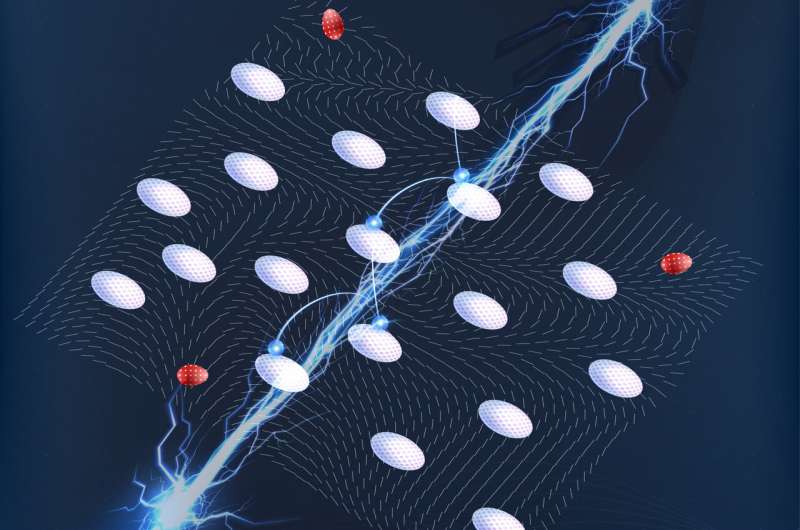Artistic rendition of disordered anisotropic Wigner solid composed of frozen electrons (pinned by the disorder) arranged in an anisotropic lattice. Credit: Hossain et al.
Physicists have been trying to determine the ground states of 2D electron systems at extremely low densities and temperatures for many decades now. The first theoretical predictions for these ground states were put forward by physicists Felix Bloch in 1929 and Eugene Wigner in 1934, both of whom suggested that interactions between electrons could lead to ground states that had never been observed before.
Researchers at Princeton University have been conducting studies in this area of physics for several years now. Their most recent work, featured in Physical Review Letters, gathered evidence of a new state that had been predicted by Wigner, known as a disordered Wigner solid (WS).
"The phase predicted by Wigner, an ordered array of electrons (the so-called Wigner crystal or WS), has fascinated scientists for decades," Mansour Shayegan, principal investigator for the study, told Phys.org. "Its experimental realization is extremely challenging, as it requires samples with very low densities and with appropriate parameters (large effective mass and small dielectric constant) to enhance the role of interaction."
To successfully produce a WS or quantum WS in a laboratory setting, researchers need extremely pure and high-quality samples. This means that the substances they use in their experiments must have a minimal number of impurities, as these impurities can attract electrons and prompt them to re-arrange themselves randomly.
As satisfying the requirements for producing these states is very challenging, previous studies probing quantum WS systems, in which electron-electron interactions dominate over the so-called Fermi energy, have been incredibly scarce. The first quantum WS was observed in 1999 by Jongsoo Yoon at Princeton University and some of the researchers involved in the recent study, using a GaAs/AlGaAs 2D heterostructure.
In their new study, the team used a clean and highly pure 2D AlAs (aluminum arsenide) sample with an anisotropic (i.e., different when measured along different directions) effective mass and Fermi Sea. Notably, their sample satisfied the requirements for the realization of an anisotropic 2D WS very well.
"Our sample is a nearly ideal platform for observing a quantum WS at zero magnetic field," Shayegan said. "Now, it turns out the 2D electrons in AlAs provide an extra bonus, namely an anisotropic energy band dispersion which leads to an anisotropic effective mass. What we found is that this anisotropy can manifest itself in the properties of the WS such as its resistance and de-pinning threshold along different in-plane directions.
The material used by Shayegan and his colleagues in their experiments consists of a high-quality AlAs quantum well, with very few impurities and thus low disorder. In this quantum well, electrons are confined within 2 dimensions.
"We can use gate voltage to tune the density of the electrons in our sample," Md Shafayat Hossain, lead author of the paper, told Phys.org. "We used a combination of electrical transport (i.e., measurements of resistivity) and DC bias spectroscopy (i.e., measurement of differential resistance as a function of source-drain DC bias) to study the anisotropic 2D disordered Wigner solid."
Measurements of the team's sample's resistivity and differential resistance showed that they had in fact observed a new quantum WS at a zero magnetic field, using an anisotropic material system. Ultimately, this allowed them to uncover the effects of anisotropy on the elusive but fascinating WS state.
"The observed Wigner solid shows different effective sliding capabilities along different directions," Hossain said. "This is manifested via different de-pinning threshold voltages along different directions observed in our experiments."
The anisotropic WS state observed by this team of researchers is likely to be an entirely new quantum state. This means that so far very little is known about its properties and characteristics.
In the future, these recent findings could thus inspire new theoretical and experimental studies aimed at better understanding this newly identified quantum state with an intrinsic anisotropy (i.e., with different values when measured in different directions). These studies could, for instance, try to determine the state's characteristic lattice shape.
"Based on our experimental findings, the different electronic behavior along different directions of anisotropic WSs can also be of use in electronic devices," Hossain said. "Such devices could respond differently depending on the direction of the applied voltage."
Ultimately, the anisotropic WS uncovered by this team of researchers could pave the way for the development of new types of anisotropic quantum devices. In their next works, Shayegan, Hossain and their colleagues will probe the microwave resonances of the state they uncovered, as these could provide more details about the state and its anisotropy.
"For example, we will ask: does the WS show resonances, similar to what has been seen in the case of magnetic-field-induced WSs, at very small fillings (high magnetic fields)?" Shayegan added. "Observing resonances would be very helpful as they would provide strong evidence for the WS phase. Also, observing resonances whose frequencies depend on the orientation of the applied electric field with respect to the orientation of the WS crystal would be fascinating, and would shed light on the role of anisotropy."
More information: Md. S. Hossain et al, Anisotropic Two-Dimensional Disordered Wigner Solid, Physical Review Letters (2022). DOI: 10.1103/PhysRevLett.129.036601
Jongsoo Yoon et al, Wigner Crystallization and Metal-Insulator Transition of Two-Dimensional Holes in GaAs atB=0, Physical Review Letters (2002). DOI: 10.1103/PhysRevLett.82.1744
Journal information: Physical Review Letters
© 2022 Science X Network
























